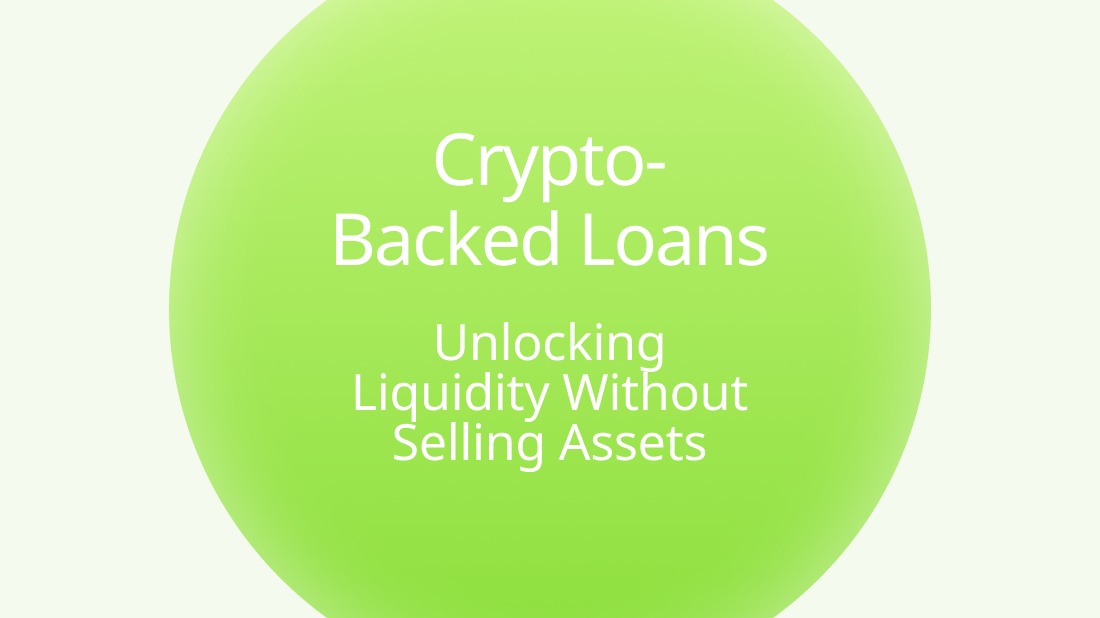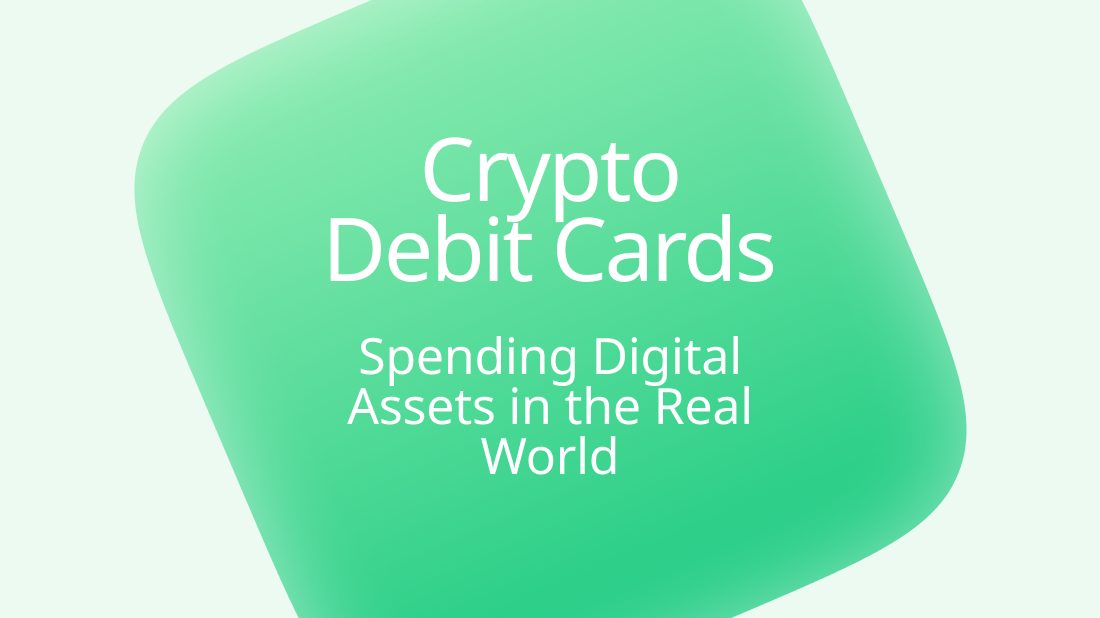Crypto-Backed Loans: Unlocking Liquidity Without Selling Assets

Cryptocurrencies have evolved from niche digital assets to mainstream financial instruments, attracting investors who see them as both a store of value and a speculative opportunity. However, one of the challenges faced by cryptocurrency holders is how to access liquidity without selling their assets, especially when they believe in the long-term appreciation of their investments. Enter crypto-backed loans—a financial innovation that allows individuals to unlock liquidity while retaining ownership of their digital assets.
In this article, we'll explore how crypto-backed loans work, their benefits, and how they provide liquidity without the need to sell digital assets. We'll also examine the growing role of these loans in digital asset management and discuss why they are becoming an increasingly popular option for cryptocurrency investors.
What Are Crypto-Backed Loans?
Crypto-backed loans are a type of secured loan where the borrower uses their cryptocurrency holdings as collateral to obtain a loan in fiat currency or stablecoins. Unlike traditional loans, which require a good credit score or other forms of collateral like real estate, crypto-backed loans rely solely on the value of the borrower’s digital assets.
The process is relatively straightforward: an individual pledges a certain amount of cryptocurrency to a lending platform, and in return, they receive a loan based on the value of that collateral. The loan-to-value (LTV) ratio typically determines how much the borrower can receive, with higher LTV ratios offering more liquidity but also posing greater risk of liquidation if the value of the collateral drops.
How Crypto-Backed Loans Work
- Choosing a Lending Platform: The first step in obtaining a crypto-backed loan is selecting a lending platform. Several platforms offer these services, each with different terms, interest rates, and supported cryptocurrencies.
- Collateralizing Cryptocurrency: Once the platform is chosen, the borrower deposits their cryptocurrency into a secure wallet provided by the platform. The amount deposited serves as collateral for the loan.
- Determining Loan Amount: The loan amount is determined based on the LTV ratio. For example, if the platform offers a 50% LTV ratio, a borrower who deposits $10,000 worth of Bitcoin as collateral could receive a $5,000 loan.
- Receiving the Loan: After the collateral is secured, the borrower receives the loan in fiat currency (such as USD or EUR) or stablecoins (such as USDT or USDC). The loan can be used for various purposes, such as paying off debt, investing in other assets, or covering short-term expenses.
- Repayment and Interest: The borrower is required to repay the loan over a specified period, along with interest. The interest rate may vary depending on the platform, the LTV ratio, and the loan duration. Some platforms offer flexible repayment options, allowing borrowers to pay back the loan at their convenience, while others may have fixed schedules.
- Loan Repayment and Asset Release: Once the loan is fully repaid, including any interest, the borrower’s cryptocurrency collateral is returned. If the borrower fails to repay the loan or the value of the collateral falls below a certain threshold, the platform may liquidate the collateral to cover the loan amount.
Benefits of Crypto-Backed Loans
Crypto-backed loans offer several advantages, particularly for those who want to maintain their cryptocurrency holdings while accessing liquidity.
1. Preservation of Cryptocurrency Holdings
One of the most significant benefits of crypto-backed loans is that they allow borrowers to unlock liquidity without selling their assets. For many cryptocurrency investors, selling their holdings can be a tough decision, especially if they believe the value of their assets will increase over time. By using a crypto-backed loan, they can access the funds they need while still benefiting from potential future appreciation.
2. Tax Efficiency
Selling cryptocurrency can trigger capital gains taxes, which vary depending on the jurisdiction and the length of time the asset was held. By using a crypto-backed loan instead of selling, investors can defer taxes and potentially reduce their tax liability. This strategy is particularly beneficial for long-term holders who want to avoid realizing gains prematurely.
3. Flexibility and Accessibility
Crypto-backed loans are generally more accessible than traditional loans, as they don’t require a credit check or extensive documentation. This makes them an attractive option for individuals who may not have a strong credit history or who prefer not to go through the lengthy process of obtaining a traditional loan. Additionally, borrowers can often choose the loan amount, duration, and repayment terms that best suit their needs.
4. Competitive Interest Rates
The interest rates on crypto-backed loans are often competitive compared to traditional personal loans or credit cards. While rates can vary depending on the platform, the LTV ratio, and market conditions, they are generally lower than unsecured loan options. This makes crypto-backed loans an appealing choice for those looking to borrow at a reasonable cost.
5. Access to Immediate Liquidity
In the fast-paced world of cryptocurrency, timing can be everything. Crypto-backed loans provide immediate access to liquidity, allowing borrowers to take advantage of opportunities or address urgent financial needs without waiting for a traditional loan approval process.
Risks and Considerations
While crypto-backed loans offer numerous benefits, they also come with certain risks and considerations that potential borrowers should be aware of.
1. Volatility of Cryptocurrency Prices
The value of cryptocurrencies can be highly volatile, which poses a risk for both the borrower and the lending platform. If the value of the collateral drops significantly, the borrower may face a margin call, requiring them to add more collateral or risk liquidation. This can result in the loss of the borrower’s assets if they are unable to meet the margin call requirements.
2. Liquidation Risk
In the event of a significant market downturn, the lending platform may automatically liquidate the borrower’s collateral to cover the loan. This means that the borrower could lose their cryptocurrency holdings, even if they were planning to hold onto them for the long term. It’s essential for borrowers to carefully monitor their collateral’s value and be prepared to take action if necessary.
3. Platform Risk
The security and reliability of the lending platform are crucial considerations. Since borrowers are entrusting their cryptocurrency to the platform, they need to ensure that the platform has robust security measures in place to protect against hacking and theft. Additionally, borrowers should research the platform’s reputation, track record, and regulatory compliance before committing to a loan.
4. Interest Rates and Fees
While interest rates on crypto-backed loans can be competitive, they can also vary widely depending on the platform and market conditions. Borrowers should carefully compare rates, fees, and terms across different platforms to ensure they are getting the best deal. It’s also important to factor in any hidden fees, such as origination fees or early repayment penalties.
The Growing Role of Crypto-Backed Loans in Digital Asset Management
As the cryptocurrency market continues to grow and mature, crypto-backed loans are becoming an increasingly popular tool for digital asset management. Investors are using these loans to unlock liquidity, diversify their portfolios, and access funds without selling their holdings. Additionally, crypto-backed loans are being integrated into more sophisticated financial strategies, such as arbitrage, yield farming, and portfolio rebalancing.
DeFi Platforms and the Future of Crypto Loans
The rise of decentralized finance (DeFi) platforms has further expanded the possibilities for crypto-backed loans. DeFi platforms like Aave, Compound, and MakerDAO allow users to borrow and lend cryptocurrencies without relying on a central authority. These platforms use smart contracts to automate the loan process, providing greater transparency, security, and accessibility.
DeFi platforms also offer unique features, such as flash loans, which allow users to borrow funds without collateral as long as the loan is repaid within the same transaction. This innovation has opened up new opportunities for traders and developers, further enhancing the utility of crypto-backed loans in the digital economy.
Conclusion
Crypto-backed loans represent a powerful financial tool for cryptocurrency investors, offering a way to unlock liquidity without selling their assets. By preserving their cryptocurrency holdings, investors can benefit from potential future appreciation while accessing the funds they need today. However, it’s essential for borrowers to carefully consider the risks, including the volatility of cryptocurrency prices, liquidation risks, and platform security.
As the cryptocurrency market continues to evolve, crypto-backed loans will likely play an increasingly important role in digital asset management, providing flexibility, tax efficiency, and access to liquidity. Whether through traditional lending platforms or innovative DeFi solutions, crypto-backed loans are shaping the future of finance, offering new opportunities for investors and transforming the way digital assets are managed and utilized.











